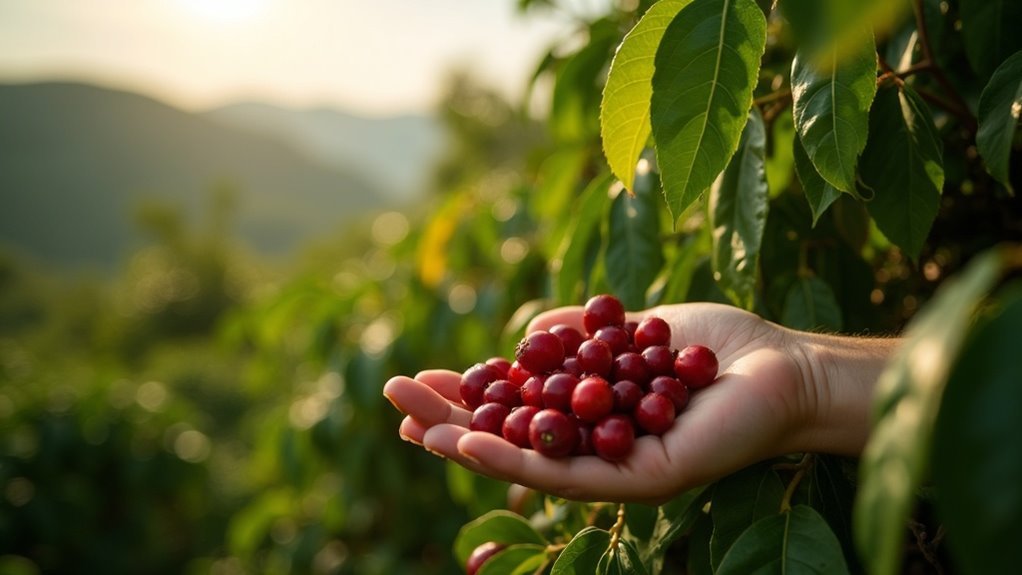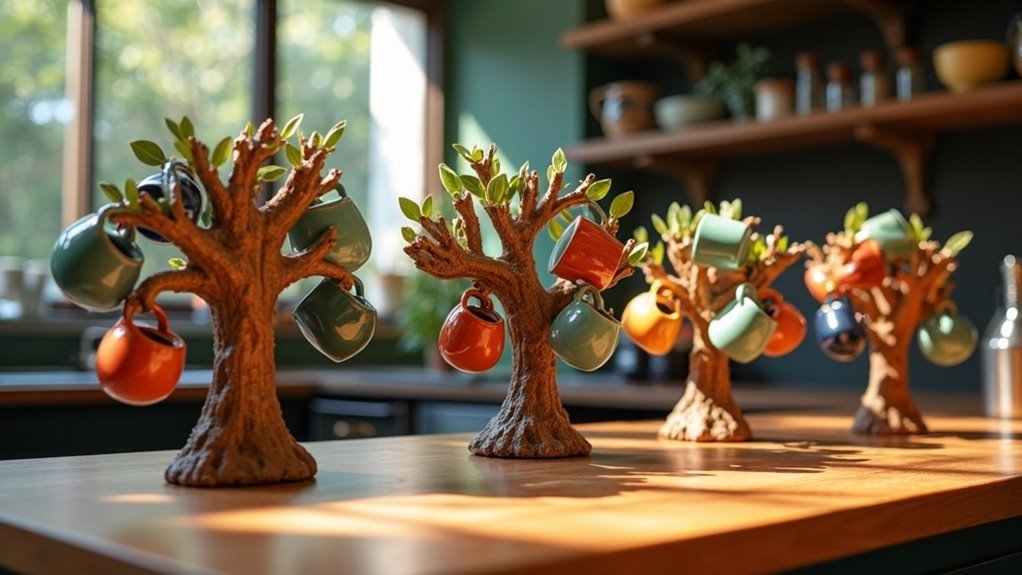Stenophylla coffee, a wild species discovered in West Africa, is gaining attention in the coffee industry due to its remarkable resilience to climate change and its ability to thrive in higher temperatures than traditional Arabica coffee. With an impressive cupping score of 80.25, Stenophylla coffee boasts a distinctive flavor profile that includes delightful notes of peach, honey, and jasmine. Its enhanced disease resistance suggests the potential for better yields, making it an attractive option for coffee growers. However, challenges such as limited seed availability and uncertain market acceptance remain. By understanding its specific cultivation needs and potential advantages, Stenophylla coffee could emerge as a valuable player in the specialty coffee market, generating increased interest among coffee enthusiasts.
Key Takeaways
- Stenophylla coffee is a remarkable wild species originating from West Africa, which was rediscovered in 2018 after being overlooked since the 18th century.
- This unique coffee thrives in warmer climates and demonstrates greater resilience to drought compared to traditional varieties like Arabica and Robusta.
- Its flavor profile is distinguished by unique notes of peach, honey, jasmine, chocolate, and caramel, boasting a cupping score that rivals that of Arabica coffee.
- However, the cultivation of Stenophylla faces challenges, including a limited supply of seeds and the absence of established farming practices.
- To address these issues, ongoing conservation efforts are focused on boosting its market presence and ensuring sustainable production, all while safeguarding its genetic diversity.
Overview of Stenophylla Coffee
Stenophylla coffee, scientifically known as Coffea stenophylla, stands out as a compelling alternative in the coffee world, particularly in light of growing climate change concerns.
Originating from West Africa, this wild coffee species flourishes at lower elevations and demonstrates impressive resilience to increasing temperatures. Its distinctive flavor profile is a highlight, featuring complex notes of peach, honey, jasmine, chocolate, caramel, and nuts.
Stenophylla coffee thrives in West Africa, boasting a unique flavor profile with hints of peach, honey, and chocolate.
Rediscovered in 2018, stenophylla holds promise for climate change resilience due to its capacity to endure drought and fend off pests.
Ongoing conservation efforts are crucial, as this species is currently considered vulnerable, facing threats from habitat loss and a scarcity of planting material that jeopardizes its future sustainability.
Historical Context and Rediscovery
The journey of Coffea stenophylla from obscurity to recognition highlights its unique position within the coffee landscape. Initially discovered by Adam Afzelius in the 18th century, Stenophylla coffee fell into neglect, overshadowed by Arabica and Robusta. Rediscovered in 2018 by Dr. Aaron Davis and Jeremy Haggar at the Royal Botanic Gardens, this species now garners attention due to its climate resilience. Current efforts focus on conservation and cultivation, ensuring its future viability as part of the diverse coffee offerings.
| Year | Event |
|---|---|
| 18th century | Discovery by Afzelius |
| 1954 | Last documentation |
| 2018 | Rediscovery in Sierra Leone |
| 2020 | Conservation initiatives |
| Ongoing | Collaborative planting efforts |
Competing With Arabica and Robusta
As climate change increasingly impacts coffee cultivation, Coffea stenophylla emerges as a viable alternative to Arabica and Robusta. This species offers several advantages for coffee enthusiasts and producers alike:
- Stenophylla can thrive in temperatures up to 6 °C higher than Arabica, making it suitable for warmer climates where traditional coffee varieties may struggle.
- It demonstrates greater drought tolerance, enhancing its viability in challenging growing conditions, which is crucial for sustainable coffee production.
- A cupping score of 80.25 highlights its competitive edge, with many evaluators mistaking its rich flavor for that of Arabica, appealing to discerning coffee drinkers.
- Stenophylla’s disease resistance positions it favorably against pests, providing a more resilient option compared to Arabica, while its unique flavor profile effectively targets the specialty coffee market.
With these benefits, Coffea stenophylla could play a significant role in the future of coffee cultivation in the face of environmental changes.
Flavor Profile and Chemical Composition
Stenophylla coffee offers a unique flavor profile that includes notes of peach, honey, and jasmine, akin to the quality found in Arabica coffee.
Its chemical composition reveals comparable levels of citric and chlorogenic acids, which are essential for flavor development, and it also contains theacrine, a compound that enhances its stimulant effects.
This remarkable combination not only contributes to its complexity but also positions Stenophylla as a significant alternative in the coffee market, appealing to coffee enthusiasts seeking new and exciting flavors.
Unique Flavor Characteristics
While exploring the flavors of coffee, you’ll discover that Stenophylla offers a remarkable complexity that sets it apart from conventional varieties.
Its unique flavor profile includes:
- Fruity notes of peach.
- Floral hints of jasmine.
- Sweet undertones of honey and caramel.
- Rich chocolate and nutty flavors.
These characteristics stem from its specific chemical composition, including the presence of theacrine and balanced levels of citric and chlorogenic acids.
With trigonelline and sucrose comparable to Arabica, Stenophylla’s coffee beans deliver an unexpected yet delightful taste experience that captivates even seasoned coffee enthusiasts.
This website is dedicated to celebrating the unique and diverse world of coffee flavors.
Chemical Composition Comparison
The intricate flavor profile of Stenophylla coffee is deeply intertwined with its unique chemical composition, setting it apart from more common varieties like Arabica and Robusta.
Stenophylla contains similar levels of citric and chlorogenic acids, which enhance its complexity. Remarkably, it features theacrine, a compound absent in other coffee species, contributing to its distinctiveness.
Research shows that its levels of trigonelline and sucrose match those of Arabica, potentially increasing its sweetness. Additionally, Stenophylla’s unique chemical composition aids in distinguishing it from counterfeit coffee, showcasing its market potential and importance in coffee production.
Understanding these elements highlights Stenophylla’s unique standing in the coffee world and its significance to coffee enthusiasts and producers alike.
Advantages and Challenges in Adoption
Stenophylla coffee offers significant advantages, such as enhanced disease resistance, which can lead to better yields under challenging growing conditions.
However, challenges such as limited seed availability and a lack of established cultivation practices may hinder its adoption among coffee growers.
Additionally, market acceptance remains uncertain, posing a potential risk to its commercial viability in an already competitive coffee landscape.
Disease Resistance Advantages
Given its higher resistance to diseases compared to traditional coffee varieties like Arabica and Robusta, Stenophylla coffee presents a promising option for farmers aiming to enhance their crop resilience.
Here are several advantages of its disease resistance:
- Higher yields in challenging conditions, which is essential for sustainability in the face of climate change.
- Withstands extreme weather, including heatwaves and droughts, ensuring its viability as a crop.
- Reduced need for pesticides, leading to lower environmental impact and management costs for farmers.
- Ongoing research focuses on specific diseases that affect Stenophylla, optimizing cultivation practices for improved crop health.
This resilient option could significantly transform coffee farming practices for the better.
Market Acceptance Challenges
While the potential benefits of Stenophylla coffee are evident, market acceptance poses significant hurdles that could slow its adoption in the coffee industry. Limited availability of seeds and planting materials hampers cultivation efforts, making it challenging for farmers to grow this unique variety. Additionally, the lack of established farming practices creates uncertainty for those interested in cultivating Stenophylla. Competing against the well-entrenched Arabica and Robusta varieties, consumer and roaster acceptance remains uncertain. Although Stenophylla offers higher yields and a lower environmental impact, initial market entry may be slow without targeted outreach to coffee enthusiasts.
| Challenge | Impact on Adoption |
|---|---|
| Limited planting materials | Slower cultivation of Stenophylla |
| Lack of farming knowledge | Hesitant farmer adoption of Stenophylla |
| Consumer uncertainty | Reduced interest in Stenophylla coffee |
| Competition with Arabica/Robusta | Stiff market resistance to Stenophylla |
Cultivation Knowledge Gaps
Understanding the cultivation knowledge gaps surrounding Stenophylla coffee is essential for its successful adoption in the coffee industry. Addressing these gaps can improve its market acceptance and sustainability. Here are some critical factors to take into account:
- Limited availability of seeds and planting material hampers widespread cultivation of Stenophylla coffee.
- Established farming practices for Stenophylla remain underdeveloped, complicating its integration into existing coffee farming systems.
- While Stenophylla’s resistance to diseases is advantageous, it requires specific cultivation techniques to maximize its potential.
- The competition with established coffee varieties, such as Arabica and Robusta, necessitates evidence of Stenophylla’s quality and yield benefits to gain traction in the market.
Future Prospects and Conservation Efforts
As the demand for unique coffee varieties grows, collaborative efforts among four institutions aim to enhance the market presence of Stenophylla coffee by planting seedlings in Sierra Leone and Reunion Island.
Long-term conservation strategies are crucial to guarantee Stenophylla’s viability, addressing its endangered status and paving the way for sustainable coffee production.
Long-term conservation strategies are essential for ensuring Stenophylla’s survival and promoting sustainable coffee production.
Research focuses on refining cultivation techniques, evaluating climate adaptability, and enhancing flavor profiles, all of which are essential for coffee lovers and specialty roasters.
The interest from specialty coffee roasters may boost demand, integrating Stenophylla into sustainable coffee initiatives.
Community engagement, including nurseries and farmer training, will help mitigate financial risks and strengthen local infrastructure for Stenophylla cultivation, ensuring that this unique coffee variety can thrive in the market.








